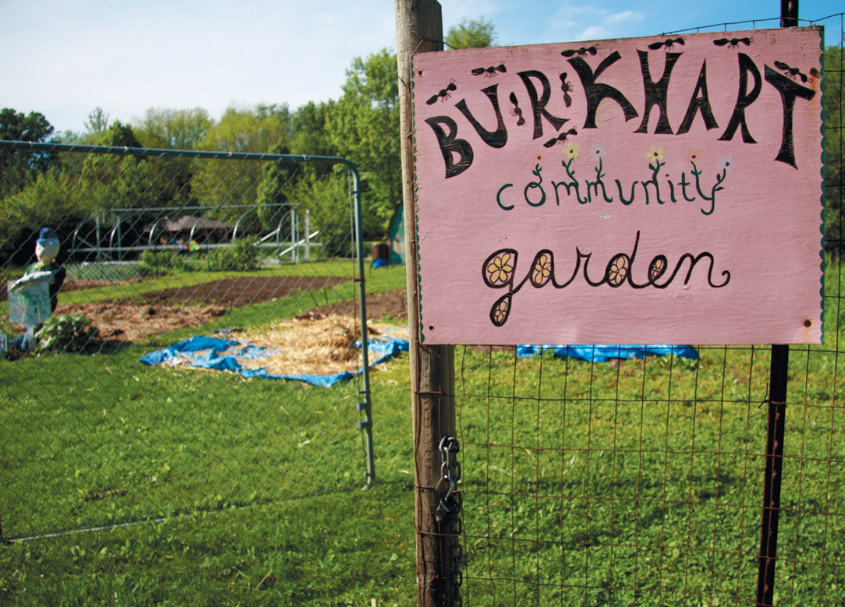Gardens in Urban Spaces
Indianapolis-area community gardens and urban gardens are growing by leaps and bounds. All over town, plots and patches are newly being cultivated, even in some of the most surprising locations.
Center Township alone was home to more than 50 urban vegetable gardens last year, according to the mayor's office, with others in the works. A driving force is Mayor Greg Ballard's urban gardens program, a collaborative effort by the Department of Metropolitan Development, the Indianapolis Land Bank and the Office of Sustainability. The program turns underutilized urban spaces into productive vegetable gardens in order to provide healthy food within "food deserts" – inner-city neighborhoods that don't have access to fresh produce because of a lack of grocery stores.
To be clear, the terms "community garden" and "urban garden" are not interchangeable, although some gardens do fall into both categories. By definition, a community garden is a shared growing enterprise undertaken by a group of people, while an urban garden refers to a public or private growing effort in an inner city or urban setting. The gardens are run by schools, churches, community groups and the city, and the harvest goes in a variety of directions. Individual gardeners can rent plots for a fee and take home what they grow. Other gardens have a charitable aspect to them, with produce going to food banks and disadvantaged families. And some supply locally minded restaurants and food trucks.
"Community gardens take in everything from small single plots to large communal spaces, but the overriding idea is that they're places that bring individuals together," says April Hammerand, project manager for the Food Coalition of Central Indiana. "There's always been a sense of community among farmers and gardeners; they look out for each other and help each other."
Plantings vary by garden, of course, and include everything from asparagus to zucchini. Perhaps reflecting the current boom in local craft beers and home brewing, Hammerand says, hops were one of the most popular community garden plantings last year.
Here's just a sampling of gardens sprouting up in Indianapolis:
• Fall Creek Gardens/Urban Growers Resource Center: At 30th Street and Central Avenue in the Mapleton-Fall Creek neighborhood, this is one of the city's newest community garden initiatives. By focusing on vegetables, herbs and flowers, Fall Creek Gardens educates the public about organic and sustainable growing methods, and also makes tools, supplies and information readily available to anyone who wants to learn more.
• Mayor's Garden Plots: The shared space for vegetable gardening at 2400 N. Tibbs St. is on a vast 20 acres, making this one of the largest community garden projects in the country. It's supervised by Indy Parks and Recreation.
• Last year, Indiana University Health, Keep Indianapolis Beautiful and Indianapolis Public Schools teamed up to launch the Riley School Gardens project among a handful of local schools. The goal? To combat childhood obesity by getting school-aged children involved in planting, tending and harvesting produce at their very own schools.
In addition to providing access to food that's fresh, healthy and nutritious, Hammerand says, shared gardens are a great community-building opportunity for the groups, organizations and individuals who manage them.
"It's really a way to bring a group or neighborhood together to share ideas, form connections and get to know each other," she says. "Children especially tend to enjoy being engaged in the gardening process, and the garden becomes a place where they can safely congregate."
• While not technically a community garden, Wishard Slow Food Garden exemplifies a successful local urban garden that serves multiple purposes. From a visual standpoint, the green space that is situated on White River State Park makes a picturesque addition to the downtown landscape.
The 6,000-square-foot space is divvied up into several plots, each intended to educate the public about a different aspect of eating local. Some of the garden's produce is sold at Pogue's Run Grocer, the co-op store at 10th and Rural streets; some becomes part of a community-supported agriculture program; and some winds up at Duos food truck, where owners Becky Hostetter and John Garnier use the produce for their local, seasonal lunch menu.
Wishard Slow Food Garden is managed and maintained by Growing Places Indy, which raises awareness of urban agriculture.
"We contribute to the foodshed in Indianapolis by selling the produce we grow, but we also want to provoke thought about people's relationship to food, especially where it comes from and how it's grown," says Laura Henderson, executive director of Growing Places Indy.
Wednesday evening work-and-learn sessions during the summer at Wishard's garden give the public a chance to dig in and get their hands dirty, and maybe discover something new at the same time.
GET INVOLVED
Care to lend a hand to your local community or urban garden? Visit www.growingplacesindy.org for information about volunteer opportunities with Growing Places Indy.
For a comprehensive map of urban and community gardens in the greater Indianapolis area, go to http://indyfoodfarmfamily.org/map/foodmap.html.






